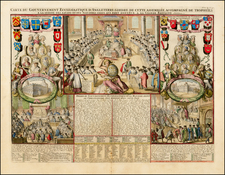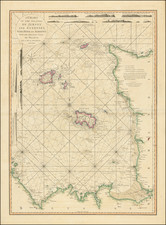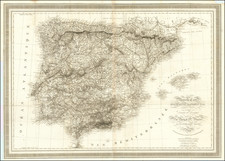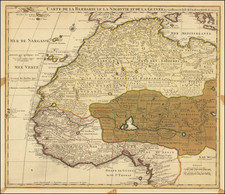Rare broadside view of Ceuta, engraved during the final Moorish Siege of Ceuta (1694-1727).
The view shows the city toward the end of the Siege, in 1720.
The view is dated based upon and advertisement in The Post Boy, 7th - 9th March, 1721. We locate only a single institutional example (British Library), which includes a key and 2 insets below the main view.
Ceuta's location has made it an important commercial trade and military way-point for many cultures, beginning with the Carthaginians in the 5th century BC, who called the city Abyla; initially Together with Gibraltar on the European side, it formed one of the famous "Pillars of Hercules". Later, it was renamed for a formation of seven surrounding smaller mountains, collectively referred to as Septem Fratres ('[The] Seven Brothers') by Pomponius Mela, which lent their name to a Roman fortification known as Castellum ad Septem Fratres.
The city changed hands numerous times during the middle ages.
The Kingdom of Fez conquered the region in 1387, with assistance from the Crown of Aragon. In 1415, during the Battle of Ceuta, the city was captured by the Portuguese during the reign of John I of Portugal.
Phillip II (King of Spain 1556-1598), ascended the Portuguese throne in 1580 and Spanish kings of Portugal governed Ceuta for 60 years (Iberian Union). During this time, Ceuta attracted many residents of Spanish origin. Ceuta became the only city of the Portuguese Empire that sided with Spain when Portugal regained its independence in 1640, and war broke out between the two countries.
On January 1.1668 by the Treaty of Lisbon, King Afonso VI of Portugal recognized the formal allegiance of Ceuta to Spain and formally ceded Ceuta to King Carlos II of Spain. However, the original Portuguese flag and coat of arms of Ceuta remained unchanged, and the modern-day Ceuta flag features the configuration of the Portuguese shield. The flag has the same background as that of the flag of the city of Lisbon. The city was besieged by Moroccan forces under Moulay Ismail from 1694 to 1727.












![[ Spain & Portugal ] Tabula II Europae (Title on Verso)](https://storage.googleapis.com/raremaps/img/small/103197.jpg)

![[ Gipuzkoa - San Sebastian ] Nova et Exactissima Descriptio Nobilis provinciae Guipuscovae in partibus Hispanae sitae](https://storage.googleapis.com/raremaps/img/small/75169.jpg)